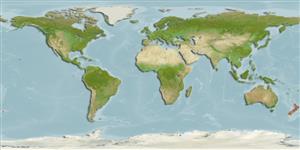Environment: milieu / climate zone / depth range / distribution range
Ökologie
seewasser; tiefenbereich 0 - ? m. Temperate
Southwest Pacific: restricted to New Zealand, including the Chatham Islands.
Size / Gewicht / Alter
Maturity: Lm ? range ? - ? cm
Max length : 26.0 cm SL Männchen/unbestimmt; (Ref. 10988); common length : 22.0 cm TL Männchen/unbestimmt; (Ref. 9258)
Rückenflossenstacheln (insgesamt): 0; Rückenflossenweichstrahlen (insgesamt): 15-18; Afterflossenstacheln 0; Afterflossenweichstrahlen: 17 - 20; Wirbelzahl: 55 - 58. Gill rakers usually 32 or less on the first arch and 25 or less on the second arch. Relatively longer upper jaw (usually longer than wide) and lower jaw (usually longer than head length), especially at larger sizes.
Occurs in inshore waters. Forms schools for spawning during mid summer (Ref. 9258). Feeds mainly on larger zooplankton like mysids, crab larvae and polychaete larvae (Ref. 26966).
Life cycle and mating behavior
Geschlechtsreife | Fortpflanzung | Ablaichen | Eier | Fecundity | Larven
Collette, B.B., 1974. The garfishes (Hemiramphidae) of Australia and New Zealand. Records of the Australian Museum 29(2):11-105. (Ref. 10988)
IUCN Rote Liste Status (Ref. 130435)
Bedrohung für Menschen
Harmless
Nutzung durch Menschen
Fischereien: weniger kommerziell
Mehr Information
NamenSynonymeMetabolismusRäuberÖkotoxikologieFortpflanzungGeschlechtsreifeAblaichenSpawning aggregationFecundityEierEientwicklung
PartnerBilderStamps, Coins Misc.LauteCiguateraGeschwindigkeitSchwimmstilKiemenoberflächeOtolithsGehirngrößeSehfähigkeit
Tools
Zusatzinformationen
Download XML
Internet Quellen
Estimates based on models
Phylogenetic diversity index (Ref.
82804): PD
50 = 0.5000 [Uniqueness, from 0.5 = low to 2.0 = high].
Bayesian length-weight: a=0.00102 (0.00046 - 0.00225), b=3.06 (2.88 - 3.24), in cm total length, based on all LWR estimates for this body shape (Ref.
93245).
Trophic level (Ref.
69278): 3.2 ±0.3 se; based on diet studies.
Widerstandsfähigkeit (Ref.
120179): hoch, Verdopplung der Population dauert weniger als 15 Monate. (Preliminary K or Fecundity.).
Fishing Vulnerability (Ref.
59153): Low vulnerability (22 of 100).
Climate Vulnerability (Ref.
125649): High to very high vulnerability (73 of 100).
Nutrients (Ref.
124155): Calcium = 240 [58, 580] mg/100g; Iron = 0.655 [0.226, 1.848] mg/100g; Protein = 17.8 [15.0, 20.0] %; Omega3 = 0.518 [0.215, 1.478] g/100g; Selenium = 6.33 [2.15, 16.41] μg/100g; VitaminA = 59.3 [11.7, 294.2] μg/100g; Zinc = 0.776 [0.306, 2.099] mg/100g (wet weight); based on
nutrient studies.
